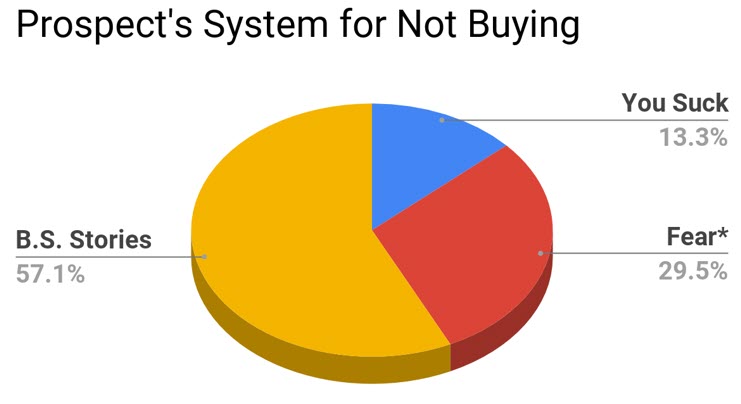The odds are stacked against you as a marketer.
Your should-be customer or client has developed a sophisticated system for NOT buying from you.
(The system is deadly effective, even though he was hardly aware that he was building it.)
One of the main components of this system is disbelief. No surprise, right?
But what most marketers don’t consider is that disbelief comes in two flavors:
1. Disbelief about your or your product/service
and
2. Disbelief about his own ability or worthiness to experience the transformation you promise.
In other words…
Your prospect can believe that you help save marriages… and disbelieve you can save HIS marriage.
To neutralize this part of the anti-buying system, you have to
1. Prove that you can deliver a result
and
2. Prove that you can deliver a result FOR HIM.
I want to talk about #2
How do you do it?
Identify the B.S. stories he tells himself… about himself.
A significant percentage of your prospects will never buy from you — not because they don’t want what you’re selling or because they don’t believe you’re good at what you do…
… but because of their limiting (dis)beliefs.
Some generic B.S. stories include
- “I’ve failed before, so trying again is pointless”
- “I’m not smart/handsome/wealthy enough”
- “People who look like me don’t/can’t do that”
- “I haven’t paid my dues yet”
- “I don’t deserve to be rich/happy because I did XYZ in the past”
You can uncover more specific crippling B.S. stories by talking (or having your team talk) with people in your target audience.
Get on the phone.
Send surveys (but take responses with a grain of salt).
Spy on them online (social media, Reddit, Amazon reviews, etc.).
You’ll gain fascinating insight you can to overcome objections in your copy.
Showcase People Like Him Who Got the Result
Once you know some of the B.S. stories, find examples about people who contradict those stories.
The more unbelieving prospect see himself reflected in your marketing messages — including his dreams, challenges, and B.S. stories — the more your message will resonate…
And the weaker his disbelief will become.
Leverage A Unique Mechanism
Position your offer as a special, proven approach your prospect has never seen before.
Show him why it’s different — and why other solutions fail.
Your unique solution helps him understand why he may have struggled in the past. And it can give him hope for future success.
Make it Ridiculously Easy to Take the First Step…
Offer a sample. A free or low cost trial. A 7-day challenge.
One of the main reasons people fail is because they never MOVE. Get them to take the first step and you unlock optimism and even confidence by default.
That confidence can force your prospect to re-examine his disbelief — especially if you…
Give Him a Quick Win
Provide information or action steps that will give him some forward momentum.
It only takes a little… and you can deliver it right inside your marketing copy if you like.
This give the prospect more confidence and trust in you. More importantly, it builds confidence and trust in his own ability to reach his goal.
An obviously you’re the person best equipped to help him do it.
Now, there’s something to be said for not convincing anyone who’s not already sure he wants to work with you.
But no matter how you approach your own business growth, it’s helpful to identify the disbelief and B.S. stories that hold your prospects (and customers) back.
You can work that knowledge into your marketing or use it to improve results inside your paid offers.
I hope this helps you grow in one way or the other.
Have a productive day.
P.S. Overcoming a prospect’s disbelief in this way is part of “killing them softly” with their own song.


